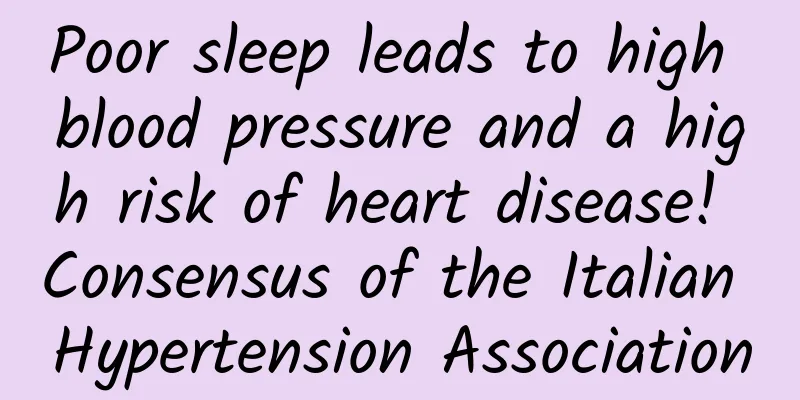Poor sleep leads to high blood pressure and a high risk of heart disease! Consensus of the Italian Hypertension Association

|
Recently, the China Sleep Research Society released the "2021 Exercise and Sleep White Paper". Data shows that more than 300 million people in China currently have sleep disorders. The Italian Hypertension Society recently published an expert consensus, pointing out that sleep disorders cause hypertension by inducing neurohormonal changes and metabolic disorders, thereby increasing the risk of cardiovascular disease and death (see figure below). A large number of studies have shown that patients with obstructive sleep apnea have a significantly increased incidence of hypertension and resistant hypertension. Nocturnal non-dipping blood pressure is also one of the factors that can modify cardiovascular risk. In the International Classification of Sleep Disorders (ICSD), sleep disorders are divided into the following categories: 1) Insomnia; 2) Sleep-disordered breathing; 3) Central hypersomnia; 4) Circadian rhythm sleep-wake disorder; 5) Hypersomnia; 6) Sleep-related movement disorder. In addition to sleep duration, people with poor sleep quality have an increased risk of cardiovascular events. But correctly classifying sleep quality is not easy. In fact, to make a correct diagnosis, complex studies such as polysomnography are usually required, which is difficult to use as a screening method in the general population. Table Sleep disorders, definitions and their implications for cardiovascular disease A recent meta-analysis in this journal showed that people with short sleep duration have a 14% and 16% increased risk of developing coronary heart disease and dying from it, respectively, while people with long sleep duration have an 8% and 24% increased risk of developing coronary heart disease and dying from it, respectively. The consensus points out that timely identification of sleep disorders, combined with lifestyle interventions, and restoration of normal sleep are of great significance for the prevention of cardiovascular disease, especially for people at high risk of cardiovascular disease. The consensus points out that insomnia and obstructive sleep apnea are most closely related to cardiovascular disease and hypertension. To diagnose sleep disorders, medical history information, physical examination and polysomnography should be collected appropriately. When taking a medical history, attention should be paid to asking about sleep habits, including bedtime and waking up times, number of awakenings at night, daytime sleep patterns, and whether there are symptoms of sleep disorders, such as daytime sleepiness, morning headaches, and involuntary movements during sleep. The physical examination is done to look for signs of obstructive sleep apnea, particularly obesity, uvula, tonsils, and bony abnormalities of the maxilla and mandible. Even nasal congestion should be noted. The physical examination should pay attention to the presence of lung disease, heart disease, or bone and spinal disease; those with sleep apnea should also undergo a neurological examination. For overweight and obese people, weight loss should first be recommended through changing diet and increasing daily physical activity. If obstructive sleep apnea is diagnosed, treatment should be given. Because it will aggravate the condition of sleep apnea, alcohol intake should be reduced and sedative drugs should be avoided. The standard treatment for obstructive sleep apnea syndrome is the use of a continuous positive airway pressure (CPAP) or bilevel positive airway pressure (BIPAP) device. If sleep apnea is related to body position, the patient should be advised to sleep in the side-lying position. Wearing a mandibular advancement device (MAD) while sleeping can also help avoid airway obstruction during sleep. There are also a number of surgical treatments for snoring; however, these must be evaluated by a specialist with experience in sleep medicine. Studies have shown that treating sleep apnea can significantly lower blood pressure, especially in patients with resistant hypertension and nocturnal hypertension. Device therapy is suitable for the treatment of mild to moderate sleep apnea. A meta-analysis of 68 randomized controlled studies showed that the use of continuous positive airway pressure ventilation can reduce systolic blood pressure by 2.09 mmHg and diastolic blood pressure by 1.92 mmHg. The use of a mandibular advancement device can reduce systolic blood pressure by 1.27 mmHg and diastolic blood pressure by 1.11 mmHg. In terms of drug treatment, drugs that can reduce the severity of sleep apnea and blood pressure are diuretics, especially mineralocorticoid receptor antagonists. The first-line treatment for insomnia is cognitive behavioral therapy, which is best done before taking hypnotics. Cognitive behavioral therapy for insomnia involves removing thoughts and behaviors that disrupt sleep. For insomnia, try to minimize abuse, misuse, and dependence on hypnotic drugs. The data on the effect of treating insomnia on blood pressure are sparse and controversial. The consensus points out that for hypertensive patients with sleep apnea, it is also necessary to consider optimizing the types and dosages of antihypertensive drugs; improving drug compliance; changing lifestyle; and promptly identifying insomnia and providing appropriate treatment. source: [1] Italian Society of Hypertension (SIIA). Diagnostic and Therapeutic Approach to Sleep Disorders, High Blood Pressure and Cardiovascular Diseases: A Consensus Document by the Italian Society of Hypertension (SIIA). High Blood Press Cardiovasc Prev. 2021, 28(2):85-102. [Download original text] [2] Zhang Xin, Wang Yan, Fan Cong, et al. Meta-analysis of prospective studies on sleep duration and risk of coronary heart disease and mortality. Chinese Journal of Circulation, 2021, 36: 258-265. DOI:10.3969/j.issn.1000-3614.2021.03.006 [Press and hold or scan the QR code below with your mobile phone to get the full text] Reprint: Please indicate "China Circulation Magazine" |
<<: What brand of gas stove is of good quality? How to maintain the gas stove
>>: What color is a normal gas stove flame? How to repair a gas stove that emits red flames
Recommend
What does progesterone follicular phase mean?
During the hormone test, there are various data o...
Will smoking affect fertility for girls? This is what the experts say!
Nowadays, many young people have the habit of smo...
Phlegm in throat during pregnancy
If there is phlegm in the throat during the secon...
Patients with hypertension need to limit salt intake, so the lighter the food, the better?
Popular saying: Patients with high blood pressure...
Can I eat ice cream when I'm pregnant?
You cannot eat cold food when you are just pregna...
How to protect the fetus during water rupture during mid-pregnancy
The experience of preserving the fetus during wat...
Why does the vagina prolapse and what should I do if it happens?
Because of difficult delivery operations, cervica...
Seven months pregnant, occasional blood in vaginal discharge
When a woman becomes pregnant, her menstruation s...
What is the cause of uterine pressure pain
Women who are pregnant know that life is growing ...
Pain below the chest
As we all know, disease prevention is something t...
What causes vaginal itching?
Problems such as vaginal itching have now trouble...
How to treat non-gonococcal cervicitis?
In life, it is difficult for many people to maint...
What should I do if I have mild uterine prolapse?
Uterine prolapse is a disease that seriously thre...
Position diagram of cupping for weight loss
Cupping stimulates the acupoints and regulates th...
What is the cause of bleeding after sex in the fifth month of pregnancy?
Having sex after pregnancy can lead to many situa...









